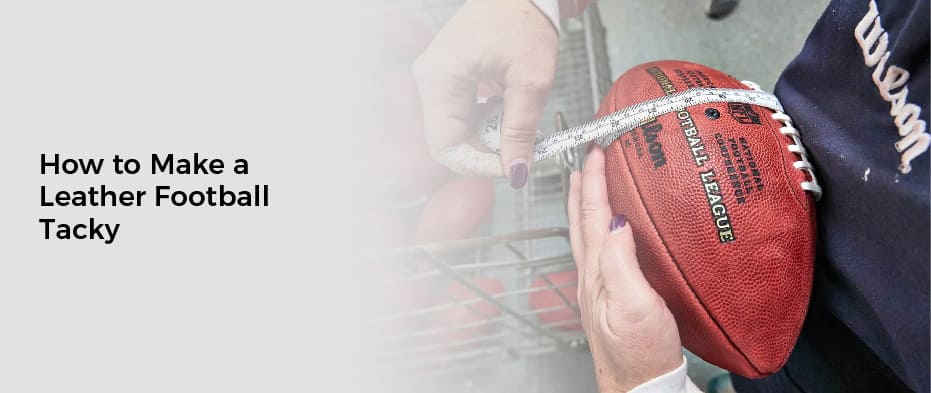How to Make a Leather Football Tacky

December 6, 2022
Leather footballs with a tacky surface are much more fun to play with than regular footballs, and can even give you an extra edge over your opponents. Tackiness is highly dependent on the quality of the leather used, so it’s important to choose high-quality full-grain leather and treat it with a wax or oil treatment. This will lock in moisture and create a protective layer.
How to Make a Leather Football Tacky
Lessons learned from Lena Blackburne’s Rubbing Mud
If you’ve ever watched a Major League Baseball game, you’ve probably noticed that the balls are rubbed with Rubbing Mud before the game begins. This process is required by the MLB rule book and is performed by a clubhouse attendant before every game. According to Dan O’Rourke, the Phillies’ manager of equipment and umpire services, the mud helps expose the leather on the balls and gives pitchers a better grip.
The mud is made from Feldspar, which is a super fine abrasive. Unlike juice, it doesn’t scratch the leather. In 1938, the Philadelphia A’s third base coach was reportedly complaining about the condition of his team’s baseballs. He began using the mud to prep baseballs and began using it on the field. Soon, other teams in the American League followed suit. The mud is now used by all major and minor league baseball teams.
Lena Blackburne donated her mud to the Baseball Hall of Fame in 1968. For many years, the mud was part of their Evolution of Equipment exhibit. The NFL has made it illegal to throw footballs into the stands, but the players can give away the ball to fans.
Effects of Water on leather pebbles
The production of American footballs includes the use of pebbled leather, which is a type of cowhide that is not pigskin. The pebbles in the leather help the players grip the ball. The pebbled leather is also used on the official game ball, the Wilson ‘The Duke’. Today, pebbled leather is produced using a modern version of a Woodman pressing machine that was developed in the mid-19th century. This leather is then tanned and dyed.
Pebbled leather has a rough surface with raised grooves. It’s similar to Saffiano leather, which has a cross-hatch pattern. Pebbled leather can be made from either synthetic materials or natural materials. In the past, this leather finishing process was performed manually and was slow and laborious. Woodman’s mechanized process required less physical exertion and revolutionized the pebbled leather finish.
Using Tack Spray
Using tack spray to make tack footballs is an easy way to improve the appearance of a leather football. It can be applied to the leather using a clean glove. However, you need to make sure you apply the mixture evenly on the entire leather football surface. If some spots are missed out, the tacky quality of the football will be reduced. The mixture should be left on the football for about 5 minutes and checked regularly to ensure even coverage.
Leather footballs can become extremely dry and it is important to condition them properly. There are many conditioners available, and you should purchase one that is specifically designed for footballs made of leather. You can then clean your football with a clean cloth and allow it to dry thoroughly before using it again.
Tacky makes a leather football more grip able and fun to play with. The extra grip can help give you an edge during a game. The quality of the leather also plays a big role in the tacky quality. If you are using full-grain leather, be sure to apply oil or wax to it to lock in moisture and form a protective layer.
Using Scotch Tape
Using a leather football tacky can be a great way to make the football more durable and to make catching the football easier. A leather football tacky is a great addition to your football if you want to increase the friction between it and the ground, which can be very important for quarterbacks and receivers. However, there are a few things to consider before using any tacky product. Some of them can cause the ball to become slippery, while others may not provide enough grip. Therefore, you should experiment with different products until you find the best one for you.
First, you need to make sure the leather you are using is made specifically for footballs. There are many different types of leather for footballs, and there are also a number of different types of glue to use to apply it. You can use traditional glue or super glue to glue the leather to the football, but be sure to use non-toxic glue, since it can get on your skin.
The next step is to clean the football. Using a shoe polish brush or Wilson-approved football brush can help you clean the football. However, you should be careful not to scrub the logo designs with this brush, as it may ruin the design. After cleaning your football, you can apply a small amount of conditioner to the surface of the leather. Use this conditioner on one panel of the football, and rub it in carefully.
Using Hot Glue
If you’re looking for a simple way to improve the durability of your football, then tacky is the way to go. Footballs are often quite worn out because players are constantly in contact with the ground and each other. Making your football tacky can help extend its lifespan and make catching and hanging on to the football much easier.
You can make your own tacky by using rosin, which is a natural resin from pine trees. It gives baseball players an excellent grip on their bats, and it works well for footballs as well. You can also thin out the rosin with alcohol or petroleum jelly. All you need is a container for mixing the ingredients and a tacky application tool.
Read Also: How to Make a Finger Football
Tacky is a great way to improve the grip of a football when it is wet. It can be applied to the surface of the football and onto the player’s gloves. Tacky can be purchased pre-made or can be made using a few simple ingredients. Make sure to store your tacky in a cool, dry place when not in use.
To apply the tacky mud, you can use a leather lax bar or a piece of leather with bristles on one side. The mixture should have the consistency of a runny goo.





